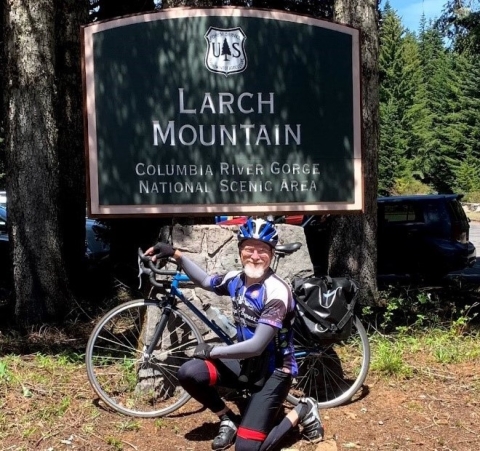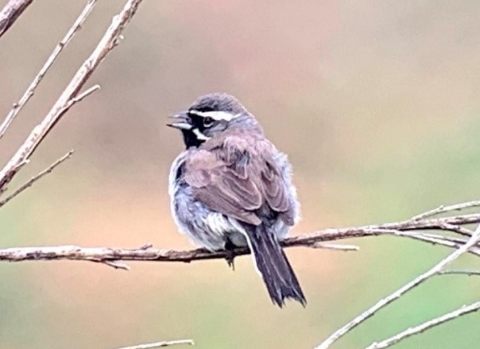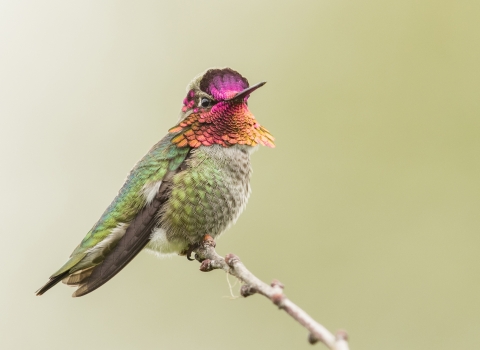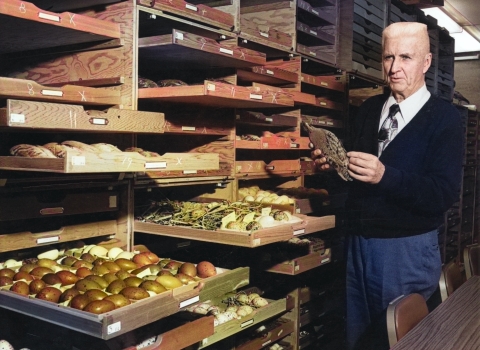“Black-throated Sparrow and Western Kingbird on Swigert Rd now. Raining but birdy,” read the message from Ross on the Portland Area Birders WhatsApp group. It was 9:17am on May 25th. I checked my calendar — I was free after 4pm. I checked the weather — it was clearing later in the day. I estimated the mileage and time required for a roundtrip by bike — about 26 miles. I decided to go for it, and I was off on my green Big Year bird chase.
I started watching birds as a kid in the 1960’s. The spare binoculars and Peterson’s Western Birds Field Guide on the kitchen shelf were legacies of my oldest brother’s Boy Scout bird-watching merit badge; the guide became my idle-time read, and the binoculars became mine by possession. I memorized the Peterson plates in the carefree way that kids easily absorb information. I focused on the hawks because they fly fast and kill stuff, which I thought (and still think) is so cool. Eventually, however, I could identify many different kinds of birds simply by sight as they showed up in the yard. I honed identification skills over the years with the help of mentors, by participating in Christmas Bird Counts, and by spending a lot of time just watching and listening. There was a point at which I came to believe that I knew the identity of every chip and song around my home in California, and that might even have been true. My ‘life list’ grew, and birding became my thing. I was also riding my bike everywhere, because I was concerned about fossil fuel use, and also because I loved it. I even dabbled in road racing during college, and took a few bike trips across western states over several summers.
A Big Year is a (mostly) friendly competition among birders for who can see the most birds in one year within a single geographic area. Why do a Big Year? Because seeing as many birds as you can during a year is simply a very fun personal challenge. It can also become ridiculously competitive among North American birders, as was documented in the 2004 nonfiction book by Mark Obmascik, which in turn was the basis of the 2011 movie The Big Year, with Jack Black, Steve Martin, and Owen Wilson. What I call a green Big Year is a challenge to see as many birds as possible in a way that doesn’t use fossil fuels. For me, this means birding by bike.
Every other year since 2017, employees with the Division of Migratory Birds in the U.S. Fish and Wildlife Service (Service) take part in a Big Year event. We use this event to encourage all staff within the program to get outside and watch birds, particularly encouraging “non-birders” to participate. Our competition is not simply about the numbers of birds that you might see in a year; it is also about the number of new species you find (which we call “lifers”), the number of birding events you participate in, the number of birders you take with you, and the number of species you might see only in your yard, and many other specialty categories. And this year we added the “green” category to many of the traditional categories — birds seen without expending fossil fuels. Tracked on a rather large spreadsheet for our 200 plus members, it is both a friendly competition and a team-building event.
Purposefully birding only by bike is not a new thing. Even as a kid in the 1970’s I fantasized about doing a Big Year by bike, strategically riding across the country to list as many species as possible. I never did that, but others have and have written about it (check out Dorian Anderson’s 2014 adventure.) Among my colleagues, one in particular is outdoing himself in this regard — Scott Somershoe. Also a former bicycle racer, Scott is not only blowing his Service colleagues out of the green birding water, he is also raising money doing it — a one man bird-a-thon. Scott has partnered with the Colorado Field Ornithologists and is raising money per species to create the Joe Roller Memorial Grant which will support bird research in Colorado. Joe Roller was a well-known ornithologist in Colorado who died in 2020. Scott’s numbers are impressive so far (246), and for my pocket-book’s sake, I hope he has multiple bicycle tire flats between now and Dec 31st (check out Scott’s blog for updates).
In addition to all of that, there is a deeper reason that drives me to hit the road with my binoculars. In the age of COVID, a green Big Year has special resonance. As people have been shut in their houses and apartments over the past year, many also have begun watching the birds that live there, in their yards, local parks, and cities. I like to think that my green Big Year amplifies that wave of interest, and maybe is a demonstration to those who are just discovering birds and who might see me out birding on my bicycle that you don’t need a car to do it.
Our Division of Migratory Birds has also embarked on another new effort this year, but aimed outward rather than inward. Nascent and developing, #BigYearAtHome is an effort to help build even more upon the swell of new interest in bird watching, and provide more opportunities for people just exploring this new interest, and, importantly, doing so in a way that supports and promotes birding among diverse communities. We have partnered with Klamath Bird Observatory and Partners in Flight to help give wings to this new effort. Our interest is earnest and our reasoning is simple, but it is that birds will be a doorway to a deeper commitment to protecting our earth (as they have for so many of my colleagues). Birds are the teachers, we are their students, and the students become earth’s stewards. As a recent publication highlights (see the 3 Billion Birds Lost paper from 2019), the time is now that we all take action; only a caring public will act.
My hope is that the bird-by-bike message at least resonates with some, and might inspire those to venture forth, maybe a little farther than they would consider going by foot, to a distant park or green space to watch birds and delight in their colors, antics, and the habitats they call home. All my birding bike trips start and stop from my garage. And yes, while I revel in a kind of absurd, modestly-competitive birding world to see as many birds as possible, most folks don’t see that — at least, I don’t think so.
My green Big Year list currently stands at 163 species, and my adventures are on a bit of a hiatus. I have a few maintenance items to deal with on my bike and too many house projects to tackle. But I rarely fail to check the WhatsApp feeds, and am always considering whether or not I might get away to see or hear any new species for the year.
I made it to Swigert Road that day, and indeed saw the Black-throated Sparrow and the Western Kingbird, as did many others over the next few days. Typical east of the Cascades, the sparrow had strayed a bit far west during his northward spring migration. I like to imagine he corrected course after his respite in Troutdale and found his way back to a more habitable site to breed.
Birding by bike doesn’t require much: a bike, helmet, and food and water (binoculars help, but aren’t necessary to have fun). Always dress for the weather. And then find a good location near you (find a spot near you on eBird). I have a bit more that I carry for longer trips, and I’ve outfitted myself to be able to carry a scope, because sometimes those birds are pretty far away. But, all of that is extra. Walking to your destination works too, and in many ways is a preferred way to find birds. And always, be safe, and have fun.






